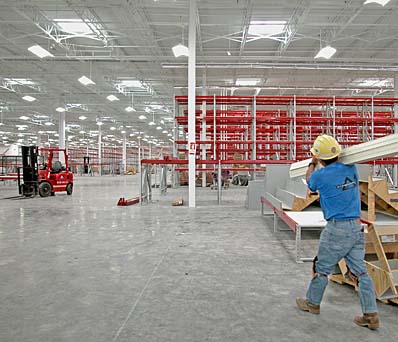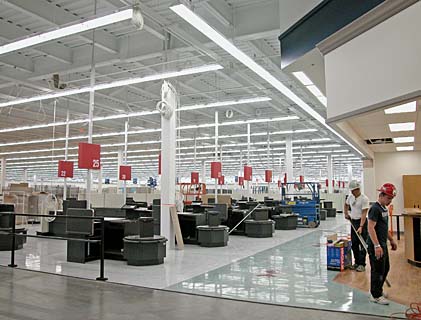

|
Massive Wal-Mart set
to open in 2 months
Local reaction to the mid-October opening of the behemoth, double-decker Wal-Mart and Sam's Club on Keeaumoku Street comes in a mixed bag.
"There's a certain segment of the community that looks forward to having a Wal-Mart and affordable shopping, but it's a very large project in an urban area and there have been many complaints from people who are concerned about the impact on traffic and on the density," said John A. Breinich, chairman of the Ala Moana Kakaako Neighborhood Board.
The 315,000-square-foot development and 1,700-stall parking deck will create a retail superblock that could easily fit Ward Warehouse, Ward Centre and Ward Village Shops, and still have room to spare. It dwarfs the mix of shops, nightclubs, condos and apartment houses that line the surrounding streets.
And it's nearly done. Signs will be posted later this week, alerting everyone, as if they could miss it, that Wal-Mart has arrived in urban Honolulu. All that's left to finish are the ramp to Sam's Club, a little landscaping work and underground utility lines. The shelves also need to be stocked with merchandise and about 500 more employees need to be hired from a growing pool of applicants.
"We're on track," said Cynthia Lin, spokeswoman for Wal-Mart. The Wal-Mart store will hold its grand opening around Oct. 13, with the opening of Sam's Club following a week later.

|
The opening of Hawaii's first stacked big-box development will bring an average of 17,000 to 20,000 cars each weekday to the heart of Honolulu, where traffic, noise and other urban woes are already major concerns.
Despite concerns from some, others say the expansion into urban Honolulu by the Bentonville, Ark.-based company is a good thing. It will stimulate job growth, increase tax revenues, draw interest to the downtown office market and help create a retail ground zero.
"It's huge and when combined with Ala Moana, it's going to create a mega-retail corridor that will pull shoppers from as far away as Pearl City and Kaneohe," said retail analyst Stephany Sofos.
Wal-Mart's nearest neighbors will be the retail sites -- including Hanazen, Golden Coin Bake Shop and Restaurant, Starbucks, Jamba Juice, Cold Stone Creamery and Supercuts -- that locate in the adjacent 4,000-square-foot shopping complex.
"With the Shops on Keeaumoku, Wal-Mart is pleased to offer customers a diverse mix of tenants -- businesses that reflect some of the local flowers of Hawaii," Lin said, adding that store openings are slated to coincide with the opening of Wal-Mart.
Rent on the 500- to 750-square-foot retail spaces in the Shops on Keeaumoku will be at a premium, said Jon-Eric Greene, leasing agent for Wal-Mart. Other rentals in the neighborhood retail for around $2.50 to $3.50 per square foot, but shop spaces anchored by a Wal-Mart typically will fetch 30 to 50 percent higher rents than the highest market rates, Greene said.
While many surrounding businesses believe the boost in traffic could pump up sales, other smaller businesses fear they will be obscured by the hulking shadow of the beige monolith, which stretches across 10.5 acres.
The retail giant began eyeing Keeaumoku as another potential location in the 1990s. Developers have kicked around proposals for the vacant Keeaumoku site since the late 1980s.
Haseko Hawaii Inc. once planned a $400 million retail, luxury condominium and office project for the site but the slowdown of the state's economy stopped the project. Once Wal-Mart stepped in, it met with opposition from some of the 537,554-plus residents who live within a 10-mile radius of the area as well as some of the smaller businesses whose owners worried about competition. The project was also criticized for its potential to create additional traffic concerns in the dense urban area.
The project was temporarily halted by two lawsuits. A group of Keeaumoku-area residents and a union filed a lawsuit last winter claiming that the development would create a downtown nuisance, and last spring a group of native Hawaiians filed suit after human remains were found on the site.
There have been 44 sets of remains found at the Wal-Mart site since construction began in December 2002, most of which are believed to have been buried after a smallpox epidemic in 1853.
Before Wal-Mart began work at the superblock, officials conducted an archaeological assessment and found no remains at the site, Lin said, adding that the disinterred remains will be buried in a single location sometime after the grand opening.
Wal-Mart has widened and realigned streets, installed two traffic signals and modified sidewalks and curbs to accommodate pedestrians, taxi cabs and mass transit, Lin said.
To help with congestion when it opens, the store also plans to assign 20 associates and hire 10 Honolulu police officers to help direct traffic, she said.